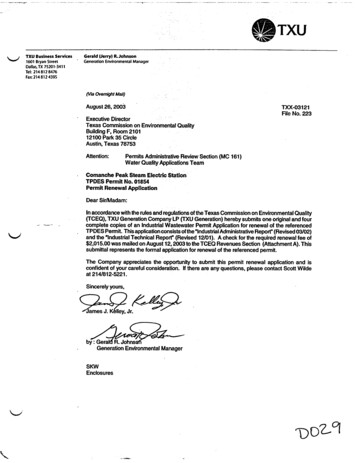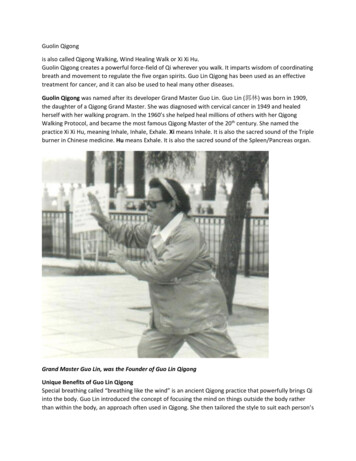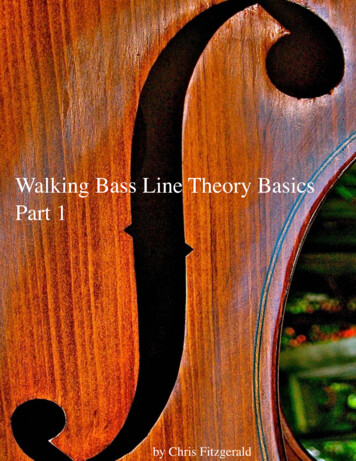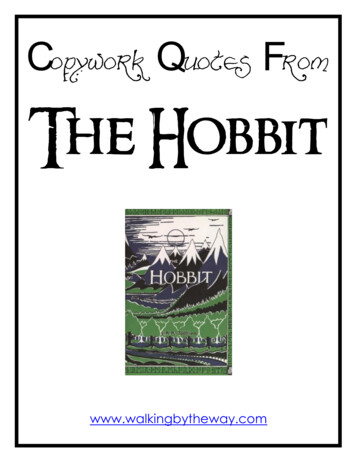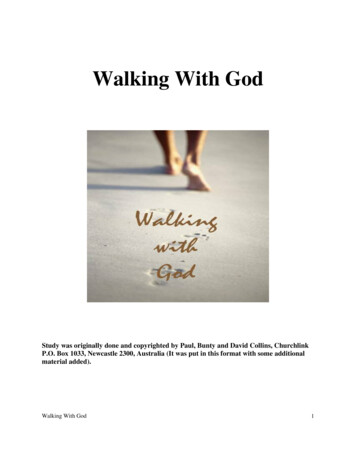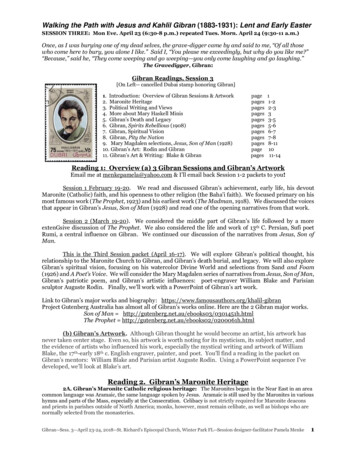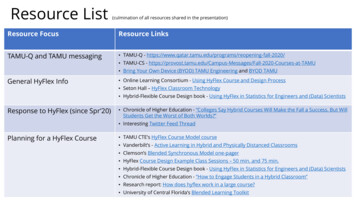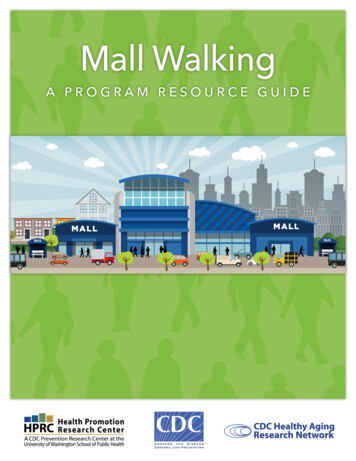
Transcription
Mall WalkingA PROGRAM RESOURCE GUIDE
Suggested CitationBelza B, Allen P, Brown DR, Farren L, Janicek S, Jones DL, King DK, Marquez DX,Miyawaki CE, Rosenberg D. Mall walking: A program resource guide.Seattle, WA: University of Washington Health Promotion Research Center; /mallwalking-guide.pdfImages in Mall Walking: A Program Resource Guide are numbered.See the photo credits on page 34 for a complete list of photos.For additional information, please contactBasia Belza, PhD, RN, FAANUniversity of WashingtonE-mail: basiab@uw.eduWebsite addresses of nonfederal organizations are provided solely as a serviceto readers. Provision of an address does not constitute an endorsement of thisorganization by CDC or the federal government, and none should be inferred.CDC is not responsible for the content of other organizations’ web pages.
ject Advisory Group1Introduction3Why Mall Walk?26Why Walk?Mall Walking Program Considerations16 Examples of Mall Walking Programs25 Think Beyond a Traditional MallWalking Program32 References34 Photo Credits35 Appendices44 Walking Resources
AuthorsBasia Belza, PhD, RN, FAANHealth Promotion Research Center, School of Nursing,University of WashingtonLaura Farren, BSHealth Promotion Research Center, University of WashingtonChristina E. Miyawaki, PhD, MSWGroup Health Research Institute, Health PromotionResearch Center, University of WashingtonSarah Janicek, MEd, MADepartment of Kinesiology and Nutrition University ofIllinois at ChicagoDavid X. Marquez, PhD, FACSM, FGSADepartment of Kinesiology and Nutrition, Center forResearch on Health and Aging, University of Illinois atChicagoDori Rosenberg, PhD, MPHGroup Health Research Institute, Health PromotionResearch Center, University of WashingtonDina L. Jones, PT, PhDDepartment of Orthopaedics, Division of Physical Therapy,Injury Control Research Center, West Virginia UniversityPeg Allen, PhD, MPH, BSNPrevention Research Center, Brown School, WashingtonUniversity in St. LouisDiane K. King, PhDCenter for Behavioral Health Researchand Services, University of Alaska AnchorageDavid R. Brown, PhDNational Center for Chronic Disease Prevention and HealthPromotion, Division of Nutrition, Physical Activity, andObesity, Physical Activity and Health Branch, Centers forDisease Control and PreventionMALL WALKING : A PROGRA M RESOURC E GUIDE ii
AcknowledgementsMall Walking: A Program Resource Guide isa product of the University of WashingtonHealth Promotion Research Center, the Centersfor Disease Control and Prevention (CDC)Prevention Research Center, and was supportedby Cooperative Agreement Number U48 DP001911 from the CDC.A. Jill Wagner, MA, at IconoGraph Designs,provided the design for Mall Walking: A ProgramResource Guide, and produced the document.Special thanks to the following professionalstaff members and students who greatlycontributed to the data collection and analysis,conceptualization, and design of Mall Walking:A Program Resource Guide:Professional StaffYuki DurhamResearch Consultant, University of WashingtonStudent AssistantsLaila Tomkinson Allen, MPH studentUniversity of Alaska at AnchorageSarah Brollier, MPHUniversity of WashingtonMarc Cormier, PhDUniversity of KentuckyMichael Kelly, BSN, RNUniversity of WashingtonEmma Preston, undergraduate studentUniversity of Illinois at ChicagoNicole Schaffer, BSUniversity of Illinois at ChicagoMackenzie Staub, MSW, MPHWashington University in St. LouisJeremy Thurston, BSN, RNUniversity of WashingtonRebecca Tiffany, BSN, RNUniversity of WashingtonMALL WALKING : A PROGRA M RESOURC E GUIDE iii
Project Advisory GroupColin MilnerRachel BeyerleCommunications Director, Easter Seals Transportation GroupFounder, International Council on Active AgingRoss Okawa, MPA, MEdSeattle, WashingtonMichele L Boutaugh, BSN, MPHOffice of Nutrition and Health Promotion Programs, Administration onAging, Administration for Community Living, U.S. Department ofHealth and Human ServicesDavid Sabgir, MD, FACCFounder, Walk with a DocPaige E. DenisonEnhanceFitness National Trainer, Senior ServicesStacie SheridanExecutive Director-in-Training, Era Living Communities, SeattleChristine HardingProgram Director, Community Education Programs,National Council on AgingSusan Snyder, MSExecutive Director, Evidence-Based Leadership CouncilMargaret Haynes, MPADirector of Elder Care Services, MaineHealthGloria Neault, MSN, RNProgram Manager, Clinical Services, MaineHealthMary B. Waterman, MPHDirector, Public Health, Arthritis Foundation, National OfficeHeather Hodge, M.Ed.Director, Chronic Disease Prevention Programs, YMCA of USAMALL WALKING : A PROGRA M RESOURC E GUIDE iv
TIntroductionhe goal of Mall Walking: A ProgramResource Guide (hereafter the Guide) isto encourage the development of mallwalking programs by providing readers withinformation about the health benefits of walking,explaining why mall walking programs canhelp people walk more, and providing practicalstrategies for starting and maintaining walkingprograms in malls or other venues in areas wherea mall is not available. The information in theGuide is based on a review of research on mallwalking programs; environmental audits of mallsand other venues with walking programs; andinterviews conducted with walkers, programleaders, and managers in malls and other venueswith walking programs.This Guide is meant to inform several types ofstakeholders (or audiences). It is primarily formall managers who want to start or enhance amall walking program. However, it is also forothers in the community, who want to partnerwith their community mall to either start awalking program, or use an existing programto help their constituencies (e.g., employees,patients, seniors) walk more. This can includeaging services providers, community coalitions,work site managers, public health professionals,and hospitals and health care providers.A roadmap follows next so that you can anticipatewhat to expect as you read the Guide’s contents.This is a research-to-practice guide. The researchand rationale for planning, implementing, andevaluating mall walking programs is covered inthe Why Walk? and Why Mall Walk? sectionsof the Guide.The practice, or what to do when planning,implementing, and evaluating a mall walkingprogram, is discussed under the Mall WalkingProgram Considerations sections of theGuide, along with Examples of Mall WalkingPrograms.“How to” examples of forms that may be usedin implementing mall walking programs areprovided in the Appendices of this Guide.Finally, readers are asked to think creativelyabout how mall walking-like programs may beestablished in areas without a mall. Starting mallwalking-like programs in other settings maybe important to promote and increase walkingin rural communities. The section on ThinkBeyond a Traditional Mall Walking Programexplores these and other issues and someExamples of Other Venues Hosting MallWalking-Like Programs are provided.MALL WALKING : A PROGRA M RESOURC E GUIDE 1
Why Walk?To obtain recommended amountsof physical activity and numeroushealth benefits associated withwalking.Regular physical activity is important to overallhealth, and walking is an excellent way to beactive. Adults who engage in regular physicalactivity, such as brisk walking, are at lower riskof heart disease and stroke, type 2 diabetes,breast and colon cancers, and depressed mood,compared with inactive adults (Physical ActivityGuidelines Advisory Committee, 2008).Adults who are regularly physically active mayalso obtain other health benefits and positiveoutcomes, such as maintaining or losingweight, improving sleep, and for older adults,maintaining their independence, reducingtheir risk of falls, and delaying the onset ofcognitive decline and dementia (Physical ActivityGuidelines Advisory Committee, 2008).National Physical ActivityRecommendations for All AdultsTo gain health benefits, national guidelinesrecommend that adults, including older adults,should obtain at least 150 minutes (2 hours and30 minutes) a week of moderate-intensity aerobicphysical activity, or 75 minutes (1 hour and 15minutes) a week of vigorous-intensity aerobicphysical activity, or an equivalent combination ofmoderate and vigorous-intensity activity (U.S.Department of Health and Human Services,2008). A brisk walk is a great way to accumulateweekly minutes towards meeting the aerobicphysical activity guidelines (U.S. Department ofHealth and Human Services, 2008).Makes good public health sense!Most inactive adults can safelybegin a walking program.Walking can be done by the vast majority ofAmericans. It is an activity that requires little orno specialized skills or training, and does notrequire the purchase of expensive equipment orspecialized attire beyond comfortable walkingshoes.Persons who are inactive or unfit can begin awalking program safely. For busy adults, walkingoffers flexibility, compared to scheduled activities,such as exercise classes. Walkers can set theirown pace to fit their level of fitness, and vary thenumber of days per week and the length of theirwalking sessions to fit comfort level. As walkersgradually improve their fitness level, they canincrease the frequency, intensity, or durationof the walking they perform during the week.Walking programs can, and should, be tailoredto include persons with varying levels of mobility(e.g., slow and fast walkers, walkers using assistivedevices, and walkers with disabilities).MALL WALKING : A PROGRA M RESOURC E GUIDE 2
Why Mall Walk?To address barriers to physicalactivity.Regardless of residential or work locations,walking can be done in a variety of venues.However, many neighborhood environmentfactors, such as street layout, sidewalk conditions,proximity of desirable destinations, perceivedsafety from traffic, and crime, all influencewalking-related physical activity (Rosenberg,Huang, Simonovich, & Belza, 2013; Saelens &Handy, 2008; Van Cauwenberg et al., 2011).These factors associated with neighborhoodwalkability are important for all Americans,but especially for many midlife and olderadults with physical or cognitive disabilities(Nagel, Carlson, Bosworth, & Michael, 2008;Prohaska et al., 2009; Satariano et al., 2010).Although neighborhoods can be designed tobe walkable and, therefore, promote walking(Belza et al., 2004; Rosenberg, Bombardier,Hoffman, & Belza, 2011), external conditions,such as extreme temperatures and inclementweather, may negatively influence walking andincrease safety hazards (Rosenberg et al., 2013).Mall walking programs can address many ofthese barriers, as noted in Table 1, which maylargely account for findings indicating thatafter neighborhoods, shopping malls (“mallwalking”) are the second most frequently usedvenue for walking (Eyler, Brownson, Bacak, &Housemann, 2003).1Well-lit and wide walking route free of obstacles.Mall walking is considered a safe, comfortablephysical activity mode (Eyler et al., 2003),and walking at malls is often recommended byhealth care providers because malls offer free,relatively accessible, and pedestrian-friendlyenvironments (Cuaderes, Lamb, & Alger, 2014).Malls are attractive places for walking becausethey provide a sheltered indoor environmentfree from the dangers of traffic congestion, andcan be used most days of the year regardless ofweather or seasonal differences. Security staffare usually present so people feel less fearfuland vulnerable when walking in malls than inmore unpredictable environments (Duncan,Travis, & McAuley, 1994; Schacht & Unnithan,1991; Standefer, 1992). In addition, mallshave level surfaces, benches for places to rest,water fountains for availability of free water, andaccessible restrooms.MALL WALKING : A PROGRA M RESOURC E GUIDE 3
Why Mall Walk?Mall Walking Programs May Help People Overcome Barriers toPhysical ActivityBarriers to Physical ActivityMall Characteristics(Lattimore, et al, 2011)Weather (too hot, too cold,The majority of malls provide atoo inclement)temperature-controlled indoorenvironment that can be used forwalking, regardless of seasonal changesand conditions.Neighborhood safety;fear of crimeMall security staff and presence ofother walkers and shoppers help toalleviate a fear of crime that may beprevalent in other neighborhood areas.Fear of injuryAccessibility to level surfaces in amall helps reduce the risk of injuriesthat may occur with hilly and uneventerrain.Lack of resources oraccessibility to a gym orhealth clubFew resources other than properfitting walking shoes are needed forwalking in a mall. Latest fashionableworkout attire is not a requisite formall walking.Lack of social supportMall walking programs may providesupport of a program leader, as well assupport from other walking programparticipants for those who enjoywalking buddies.Lack of skills or experiencewith exercisingMost people can walk with little orno coaching or skills training. Mallwalking programs can, and should be,inclusive of persons who may havedifficulty walking.Lack of available and cleanrestroomsWell-lit restrooms available in mallsmay help overcome the worry of someadults about walking in public places,where there may not be access torestroom facilities.MALL WALKING : A PROGRA M RESOURC E GUIDE 4
Why Mall Walk?Historically, shopping malls were originallydeveloped to build a sheltered retail center forwomen after World War II, primarily in suburbanareas in the United States. The intention was forwomen to gather and socialize, and the term,“mall,” meant a promenade or shaded walkway(Standefer, 1992). Today, mall walking programscontinue to provide participants the opportunityto socialize and to shop at the various retailstores. Attractive programmatic featuresof mall walking programs are that they arenoncompetitive, sociable and friendly, and mallwalkers are typically not judged by their speed,attire, or physique. (Blair, 1988; Cresswell,2009). These a
mall walking program. However, it is also for others in the community, who want to partner with their community mall to either start a walking program, or use an existing program to help their constituencies (e.g., employees, patients, seniors) walk more. This can
